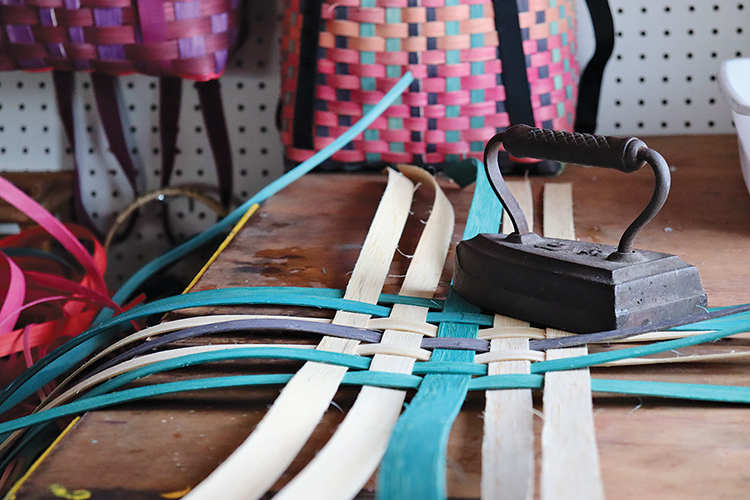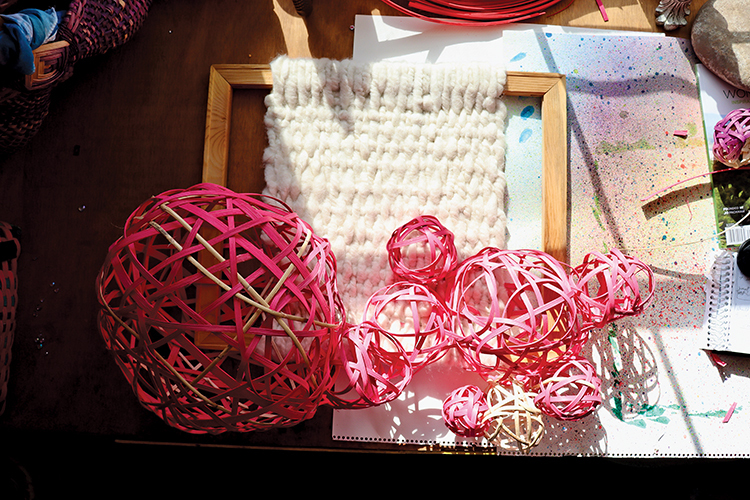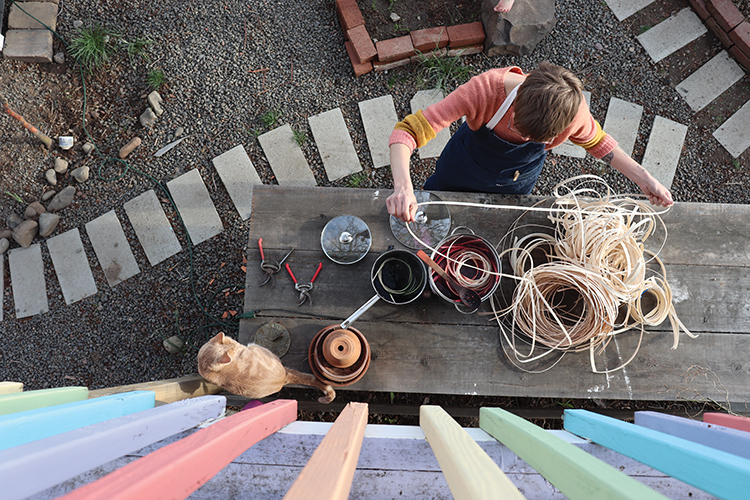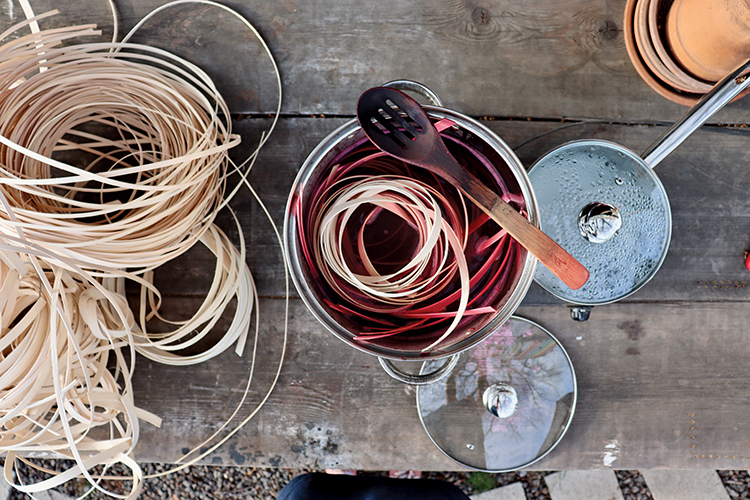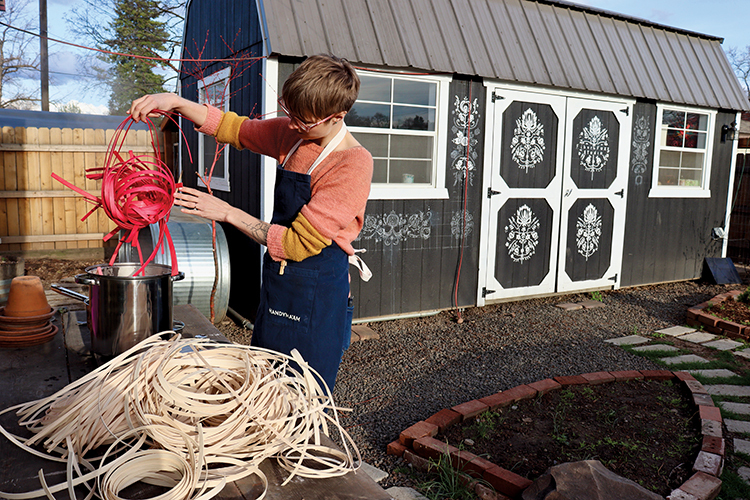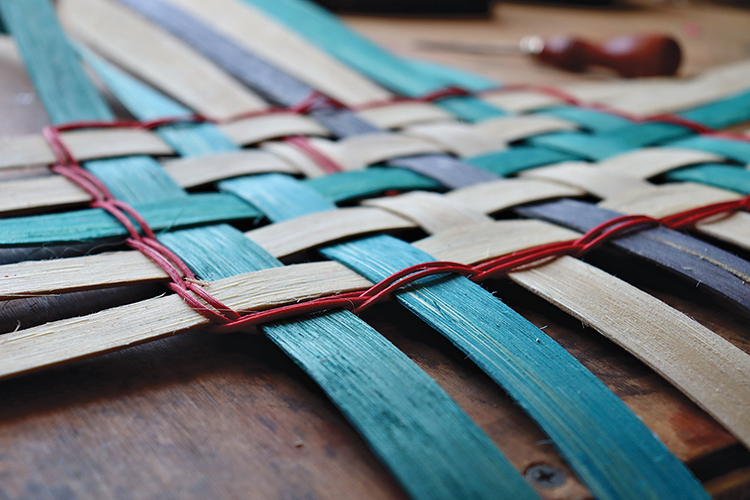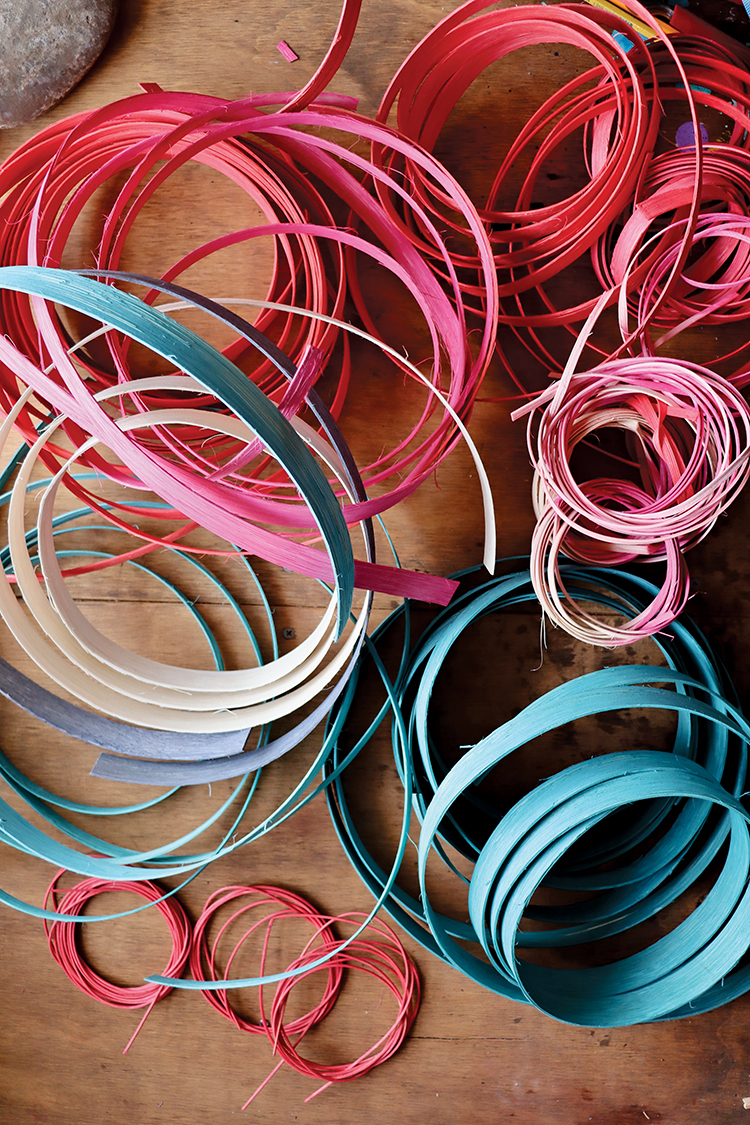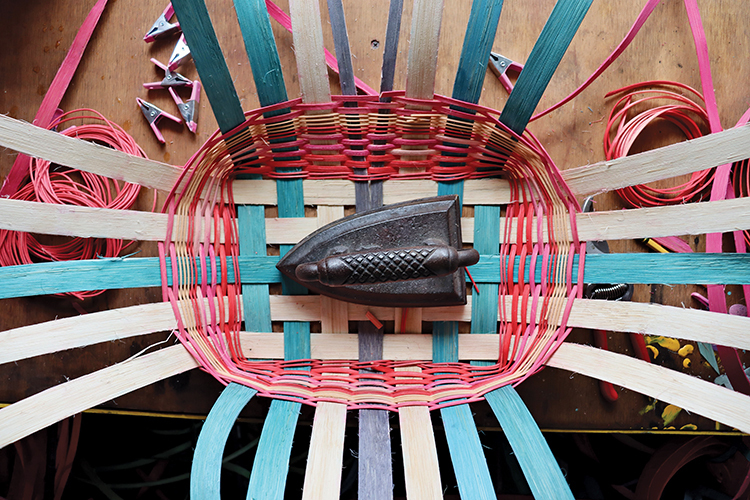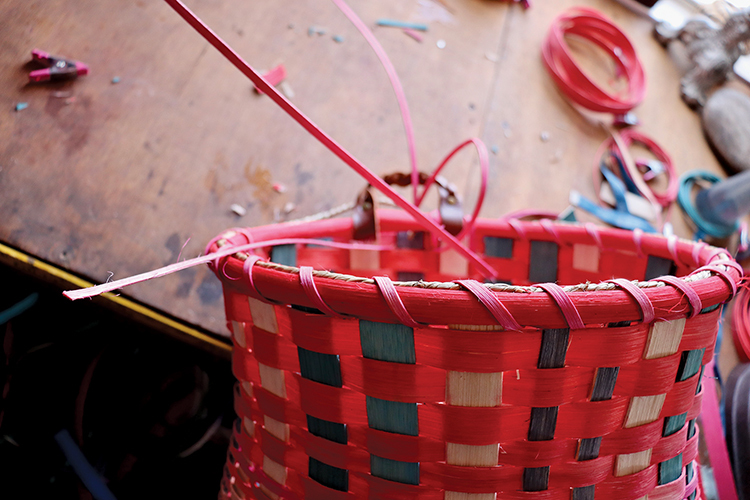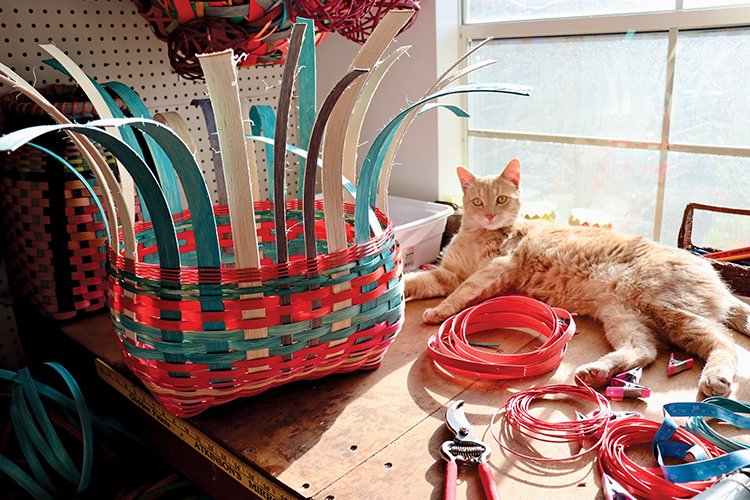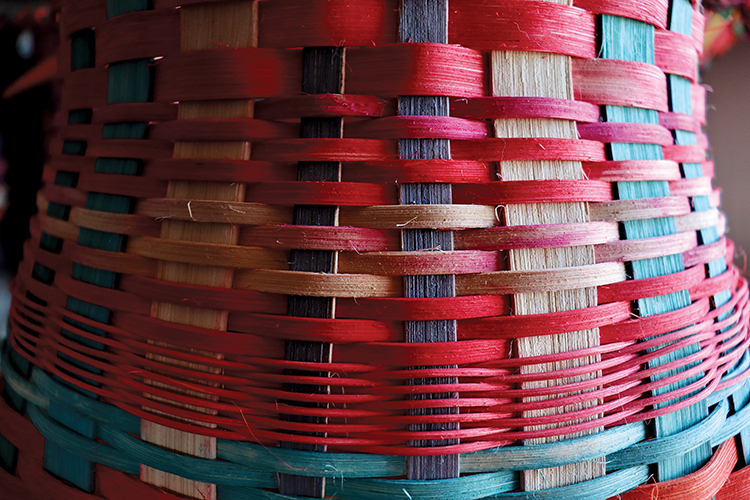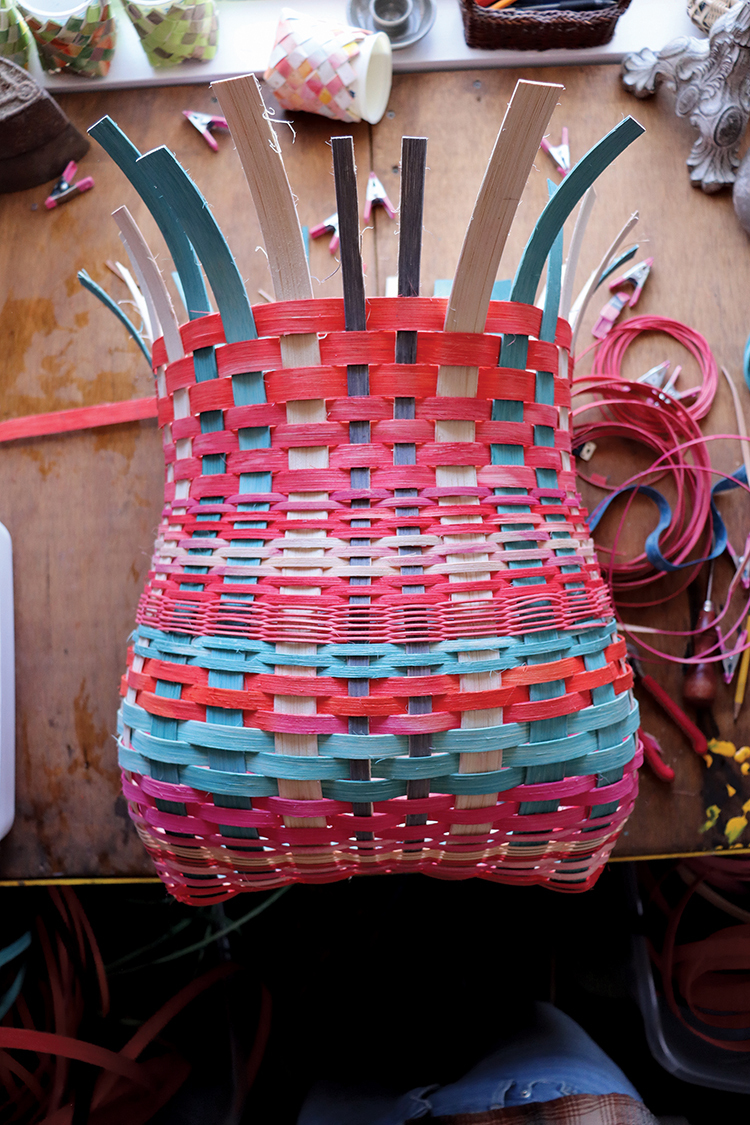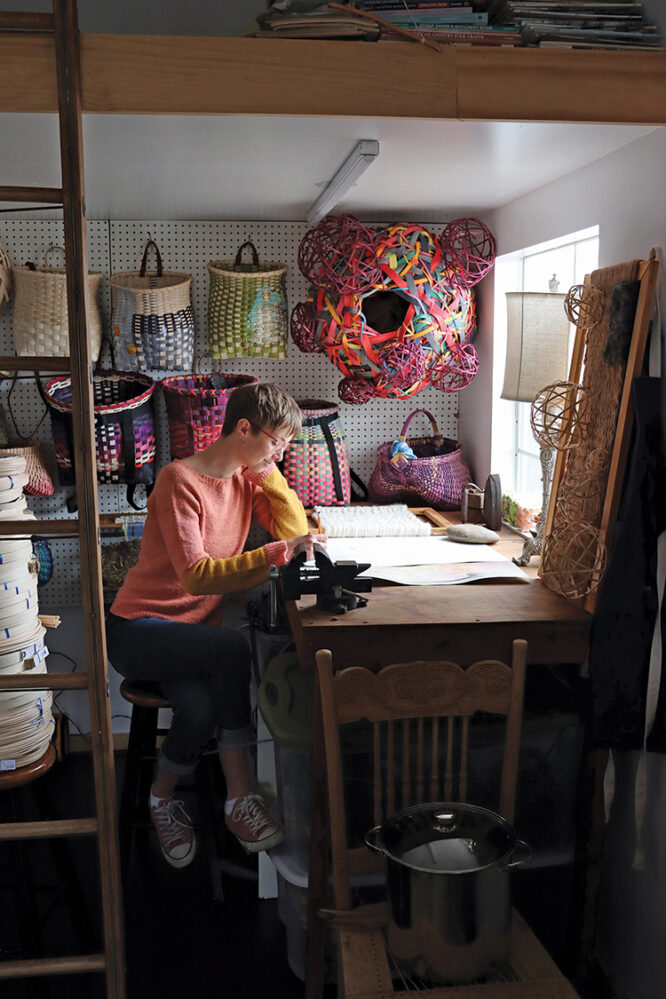
I am number nine of 10 kids. Growing up, it was always so loud in the house. The vacuum going, kids yelling, mom yelling, dogs barking, doors slamming, box TV on blast. I learned at a young age the necessity of being able to tune it out. Crafting was my main go-to to help block out all the noise. During the third grade, I began homeschooling. It was fun at first: Hours were flexible, I got to spend more time with my mom and I could have my toys with me while studying.
But as the older kids began to move out and my parents’ time got shifted to helping with my sister’s recovery after she was hit by a car, the noise at the house died down. And it not only got quiet, it got really lonely. Making things was my solace. It was my lifeline for a few years, especially when I became a teenager. I made anything and everything — crocheted scarves, beanies, cup cozies, woven beaded bracelets, paper beads, papier-mâché masks, jean quilts, costume jewelry, mobiles — and knitted everything.
In my late teens, my other sister and I even apprenticed under a local artist, Bill Piper. He taught us photography and some pottery, but my favorite was sculpture. I would model for my sister while she molded wax to be casted and then poured with bronze. We even got to help carve one of Bill’s own works, a limestone carving. He showed us how to chisel the smooth curves into rock. Bill was a big influence and a natural teacher.
Later, I married my best friend, Carl, and started having children. And I found myself in the unescapable solitude again that I tried so hard to escape as a child. I didn’t realize how isolating being a mom was, especially to children with special needs. Again, I turned to crafting. But it wasn’t until I picked up basket weaving that I found confidence, community and the ability to tap into some old teachings.
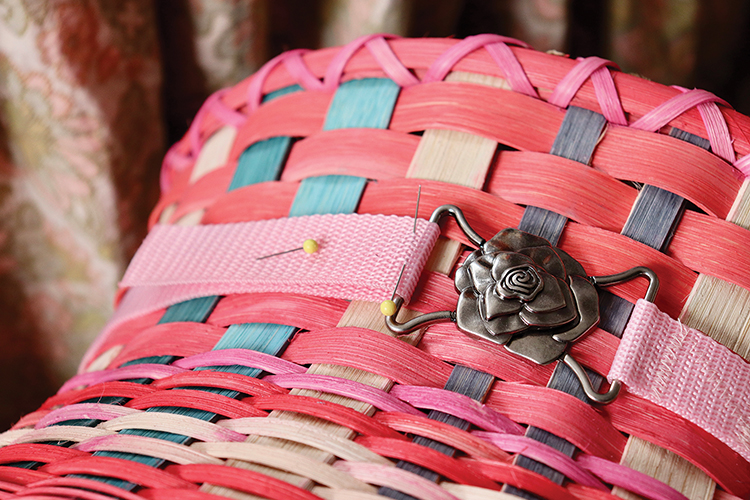
I began weaving baskets on a whim. I was originally learning how to spin fiber and weave cloth when the fiber guild emailed out a flyer about a basket-weaving workshop. It truly was love at first weave. I went to my mom and showed her my first basket as soon as the workshop was over; and by happenstance, she had a large container of rattan and books on weaving baskets in storage. She said she found them at a yard sale. I couldn’t stop playing/weaving with the material. It felt so natural yet challenging. Like the high I used to get when playing soccer in grade school. I couldn’t wait to see what style of basket I could teach myself next.
By the time my daughter turned 3, I decided I wanted to make a career out of weaving baskets. My husband thought I was crazy but supported me anyway. I had a gut feeling that I could make it work.
It was a slow lead-up to any sort of form of success. Until one day, when I decided to add color — lots of it, actually. I picked up a couple of boxes of general acid dyes and bundles of rattan and went to work.
I felt like I was breaking the rules somehow. It felt like I was graffitiing a tradition and it was exciting. The simplicity of neutrals went out the window and I was able to tap deeper into my imagination and the other possibilities there are with design and basketry.
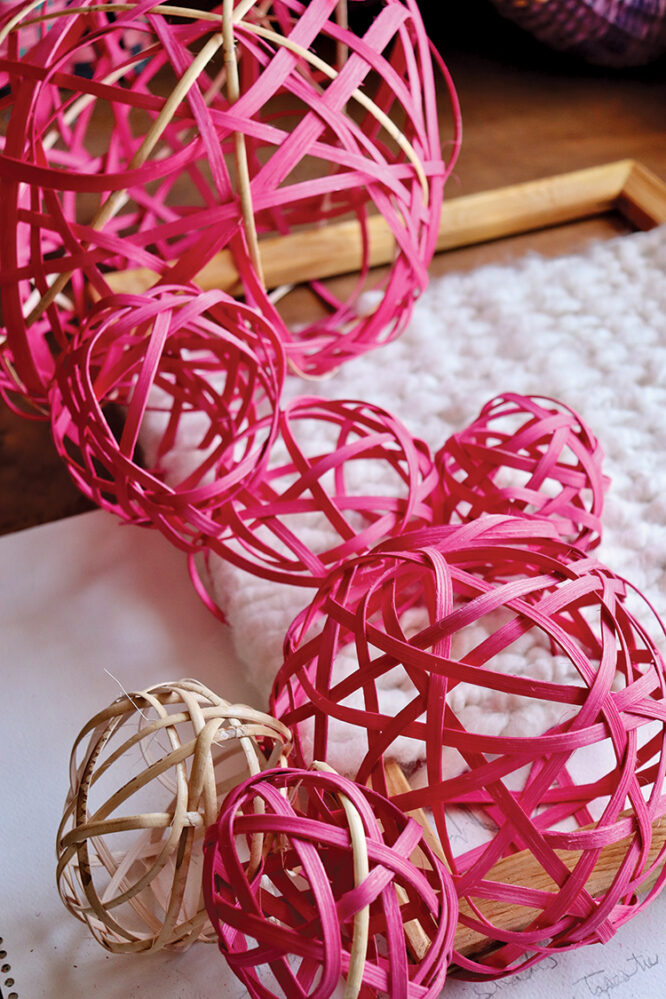
My first year selling at the local farmers’ market allowed me to weave a lot. There was so much weaving because there was a demand for it and, as a result, I put in countless hours making the same basket style again and again and again.
For someone with ADHD, that became a challenge even if every basket was colored differently. So, I started finding ways to add little changes to each basket. I would always get the most honest feedback from passersby at the market: “Honey, look! This one looks like a butt.” They would laugh and even purchase it because it put a smile on their faces and because it was unique. And to be honest, I don’t think I was charging enough. But this all fueled my already strong need to explore and experiment with texture and design.
Eventually, I began manipulating traditional techniques and developing art pieces. I feel the results represent my ever-busy mind. It came about when I had a day when I didn’t have to make something specific (at the time, I was weaving and selling my baskets at the farmers’ market) and began exploring the material more.
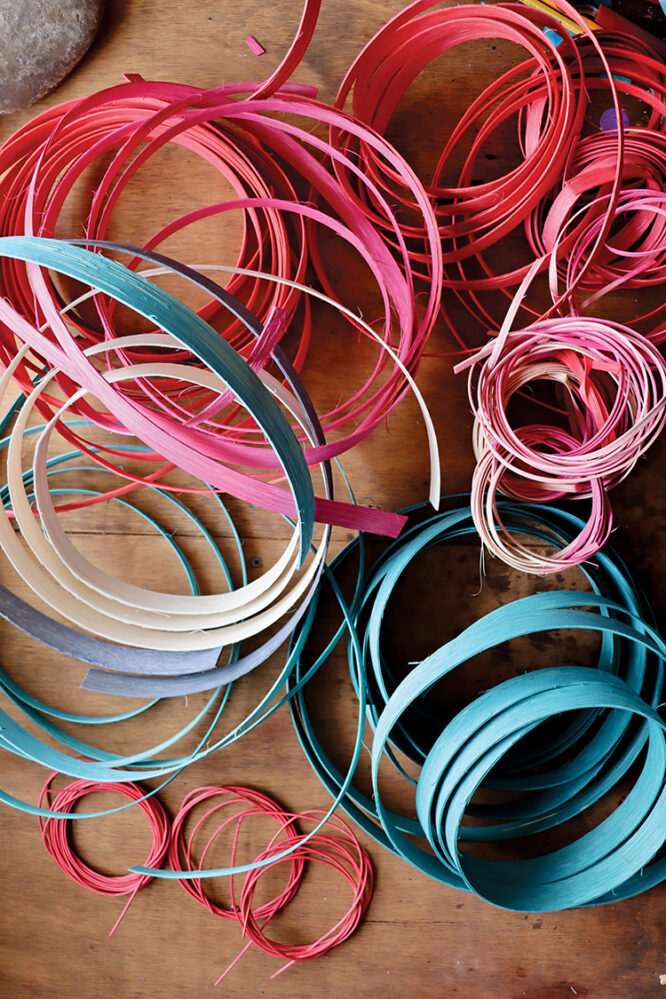
A small piece of rattan is fragile on its own. It requires a structure to create a strong functional base and shape. But if you weave multiple strands over and under each other, and after much repetition, it will hold a shape. It surprised me: It was sturdy. It was a chaotic mess. It felt like the embodiment of my mind in basket form.
Never have I been good with words, so finding an outlet to express myself has been life-changing. I never thought weaving baskets would bring me such peace within myself — especially after I realized a basket doesn’t have to look like a basket.
My process hasn’t changed much over the years. I don’t plan as much as I probably should. I am horrible at drawing so I will do a very rough sketch of shapes I have in mind. My work is primarily created from measurements. It’s hard to add length to a basket without jeopardizing its structural integrity, so one needs to make the correct cuts. Luckily, math was my strong suit in school.
I calculate base and height and any intake from the shapes I plan to explore and it’s: Snip, snip, cut, cut, and splash in some water and we are weaving. If I am planning to incorporate color — which is likely — I make sure I have the colors I need on hand or set a day to dye what I need.
I typically do big dye days, coloring as much as I can because it is a tedious process, and also because I do my best not to waste any pigment. As a result, I get a good gradient of colors through exhausting the dye baths. It’s definitely an all-day event. Combining the colors helps me determine what pattern I plan to use. Sometimes, even as I am weaving, I notice the colors will communicate a need to change the intended shape. It sounds crazy but, depending on the weaving pattern, some colors are exposed more than others and can alter the mood of the work. When an art piece is made, the question I often get is: Do you know what you’re going to make before you make it? The answer is: usually no. I trust my subconscious to communicate through the skill sets I have learned, and through my hands, to create. I think that’s why they come out emotional-looking. Often no logic is present, just a feeling that needs to be seen.
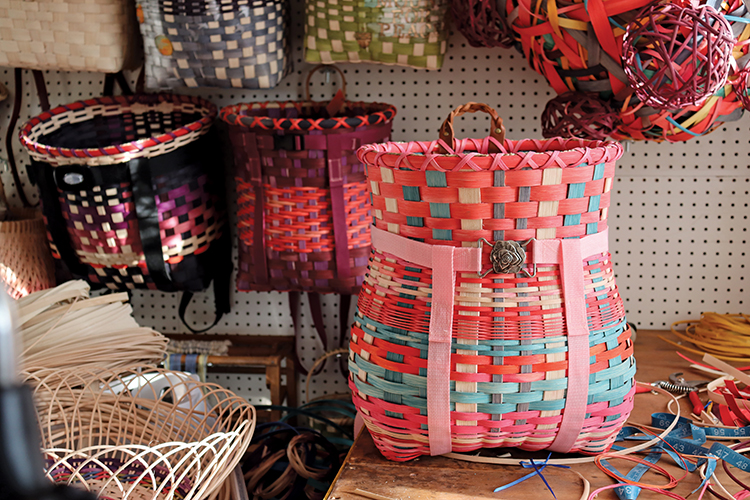
It’s hard to tell my story of where I am at without mentioning three really important creative women in my life. They played key roles in where I am today.
The bright wild colors of my baskets got the attention of others, including an amazing artist (another weaver) named Kim Nemeth. She came to my first ever pop-up and talked to me about a shop she wanted to open. The back would be for her studio and the front would be full of local artisan goods. A space for functional art, she called it.
A few months later, she opened up shop and now some of my work is available for purchase at The Cotton Wool. Kim’s themed group shows have aided in my growth in art, simply by being a fun challenge and giving the verbal directive of freedom to do what we want.
Sometime between the initial conversation with Kim and the opening of her shop, I was approached by another woman looking to secure business in a craft, Jess Portas (a potter). She was getting ready to land a location to open the first all-access pottery studio in Walla Walla. But she wanted to diversify it a little by offering classes in other mediums. So, she asked me, “Will you teach basketry at The Refinery?” Of course, I said yes. And until I open up my own class space, at the future “Basket Ranch,” I teach basketry classes there.
But the one who was there in the beginning, who egged me on to try out the market, who listened to me cry about balancing parenting and hand-crafting artwork, is Elaine Vandiver of Old Homestead Alpacas (a shepherdess). The fiber from her alpacas is incorporated in my tapestry pieces.
Whenever either of us is having a rough day at work, there’s a quick text message back-and-forth and we are back at it. And when we have a successful new launch, we are ready to celebrate each other’s winnings. She is also the one who kept pushing me to set up my website and start a monthly newsletter.
I truly don’t know where my business or woven work would be without these inspiring women in my corner.
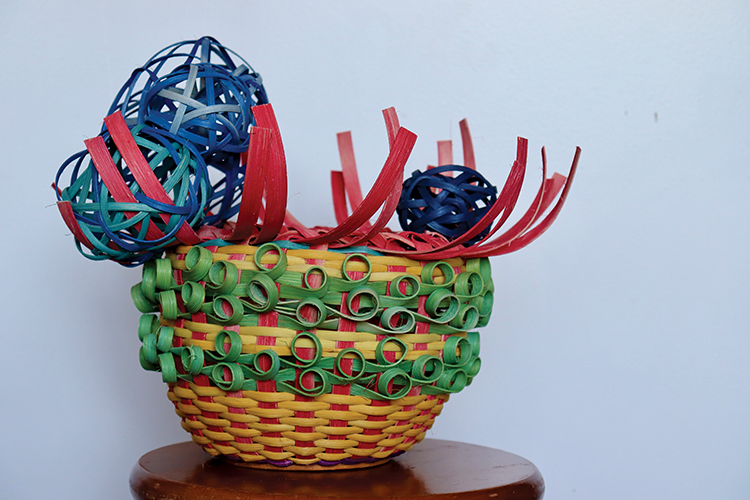
Just this year we purchased a fixer-upper on a good-sized lot on the edge of town. There is enough land to grow plants for basket weaving. It will be the Basket Ranch. On weekends, we will have basket-weaving retreats and also a gift shop by the roadside.
The kids are excited to help and are already planning their own entrepreneurial endeavors. Of course, we are just in the beginning planning phase of this undertaking. But we have high hopes things will be open in a year.
In the meantime, you can find my work at The Cotton Wool and sign up for an in-person basketry class at The Refinery.

I am number nine of 10 kids. Growing up, it was always so loud in the house. The vacuum going, kids yelling, mom yelling, dogs barking, doors slamming, box TV on blast. I learned at a young age the necessity of being able to tune it out. Crafting was my main go-to to help block out all the noise. During the third grade, I began homeschooling. It was fun at first: Hours were flexible, I got to spend more time with my mom and I could have my toys with me while studying.
But as the older kids began to move out and my parents’ time got shifted to helping with my sister’s recovery after she was hit by a car, the noise at the house died down. And it not only got quiet, it got really lonely. Making things was my solace. It was my lifeline for a few years, especially when I became a teenager. I made anything and everything — crocheted scarves, beanies, cup cozies, woven beaded bracelets, paper beads, papier-mâché masks, jean quilts, costume jewelry, mobiles — and knitted everything.
In my late teens, my other sister and I even apprenticed under a local artist, Bill Piper. He taught us photography and some pottery, but my favorite was sculpture. I would model for my sister while she molded wax to be casted and then poured with bronze. We even got to help carve one of Bill’s own works, a limestone carving. He showed us how to chisel the smooth curves into rock. Bill was a big influence and a natural teacher.
Later, I married my best friend, Carl, and started having children. And I found myself in the unescapable solitude again that I tried so hard to escape as a child. I didn’t realize how isolating being a mom was, especially to children with special needs. Again, I turned to crafting. But it wasn’t until I picked up basket weaving that I found confidence, community and the ability to tap into some old teachings.

I began weaving baskets on a whim. I was originally learning how to spin fiber and weave cloth when the fiber guild emailed out a flyer about a basket-weaving workshop. It truly was love at first weave. I went to my mom and showed her my first basket as soon as the workshop was over; and by happenstance, she had a large container of rattan and books on weaving baskets in storage. She said she found them at a yard sale. I couldn’t stop playing/weaving with the material. It felt so natural yet challenging. Like the high I used to get when playing soccer in grade school. I couldn’t wait to see what style of basket I could teach myself next.
By the time my daughter turned 3, I decided I wanted to make a career out of weaving baskets. My husband thought I was crazy but supported me anyway. I had a gut feeling that I could make it work.
It was a slow lead-up to any sort of form of success. Until one day, when I decided to add color — lots of it, actually. I picked up a couple of boxes of general acid dyes and bundles of rattan and went to work.
I felt like I was breaking the rules somehow. It felt like I was graffitiing a tradition and it was exciting. The simplicity of neutrals went out the window and I was able to tap deeper into my imagination and the other possibilities there are with design and basketry.

My first year selling at the local farmers’ market allowed me to weave a lot. There was so much weaving because there was a demand for it and, as a result, I put in countless hours making the same basket style again and again and again.
For someone with ADHD, that became a challenge even if every basket was colored differently. So, I started finding ways to add little changes to each basket. I would always get the most honest feedback from passersby at the market: “Honey, look! This one looks like a butt.” They would laugh and even purchase it because it put a smile on their faces and because it was unique. And to be honest, I don’t think I was charging enough. But this all fueled my already strong need to explore and experiment with texture and design.
Eventually, I began manipulating traditional techniques and developing art pieces. I feel the results represent my ever-busy mind. It came about when I had a day when I didn’t have to make something specific (at the time, I was weaving and selling my baskets at the farmers’ market) and began exploring the material more.

A small piece of rattan is fragile on its own. It requires a structure to create a strong functional base and shape. But if you weave multiple strands over and under each other, and after much repetition, it will hold a shape. It surprised me: It was sturdy. It was a chaotic mess. It felt like the embodiment of my mind in basket form.
Never have I been good with words, so finding an outlet to express myself has been life-changing. I never thought weaving baskets would bring me such peace within myself — especially after I realized a basket doesn’t have to look like a basket.
My process hasn’t changed much over the years. I don’t plan as much as I probably should. I am horrible at drawing so I will do a very rough sketch of shapes I have in mind. My work is primarily created from measurements. It’s hard to add length to a basket without jeopardizing its structural integrity, so one needs to make the correct cuts. Luckily, math was my strong suit in school.
I calculate base and height and any intake from the shapes I plan to explore and it’s: Snip, snip, cut, cut, and splash in some water and we are weaving. If I am planning to incorporate color — which is likely — I make sure I have the colors I need on hand or set a day to dye what I need.
I typically do big dye days, coloring as much as I can because it is a tedious process, and also because I do my best not to waste any pigment. As a result, I get a good gradient of colors through exhausting the dye baths. It’s definitely an all-day event. Combining the colors helps me determine what pattern I plan to use. Sometimes, even as I am weaving, I notice the colors will communicate a need to change the intended shape. It sounds crazy but, depending on the weaving pattern, some colors are exposed more than others and can alter the mood of the work. When an art piece is made, the question I often get is: Do you know what you’re going to make before you make it? The answer is: usually no. I trust my subconscious to communicate through the skill sets I have learned, and through my hands, to create. I think that’s why they come out emotional-looking. Often no logic is present, just a feeling that needs to be seen.

It’s hard to tell my story of where I am at without mentioning three really important creative women in my life. They played key roles in where I am today.
The bright wild colors of my baskets got the attention of others, including an amazing artist (another weaver) named Kim Nemeth. She came to my first ever pop-up and talked to me about a shop she wanted to open. The back would be for her studio and the front would be full of local artisan goods. A space for functional art, she called it.
A few months later, she opened up shop and now some of my work is available for purchase at The Cotton Wool. Kim’s themed group shows have aided in my growth in art, simply by being a fun challenge and giving the verbal directive of freedom to do what we want.
Sometime between the initial conversation with Kim and the opening of her shop, I was approached by another woman looking to secure business in a craft, Jess Portas (a potter). She was getting ready to land a location to open the first all-access pottery studio in Walla Walla. But she wanted to diversify it a little by offering classes in other mediums. So, she asked me, “Will you teach basketry at The Refinery?” Of course, I said yes. And until I open up my own class space, at the future “Basket Ranch,” I teach basketry classes there.
But the one who was there in the beginning, who egged me on to try out the market, who listened to me cry about balancing parenting and hand-crafting artwork, is Elaine Vandiver of Old Homestead Alpacas (a shepherdess). The fiber from her alpacas is incorporated in my tapestry pieces.
Whenever either of us is having a rough day at work, there’s a quick text message back-and-forth and we are back at it. And when we have a successful new launch, we are ready to celebrate each other’s winnings. She is also the one who kept pushing me to set up my website and start a monthly newsletter.
I truly don’t know where my business or woven work would be without these inspiring women in my corner.

Just this year we purchased a fixer-upper on a good-sized lot on the edge of town. There is enough land to grow plants for basket weaving. It will be the Basket Ranch. On weekends, we will have basket-weaving retreats and also a gift shop by the roadside.
The kids are excited to help and are already planning their own entrepreneurial endeavors. Of course, we are just in the beginning planning phase of this undertaking. But we have high hopes things will be open in a year.
In the meantime, you can find my work at The Cotton Wool and sign up for an in-person basketry class at The Refinery.







